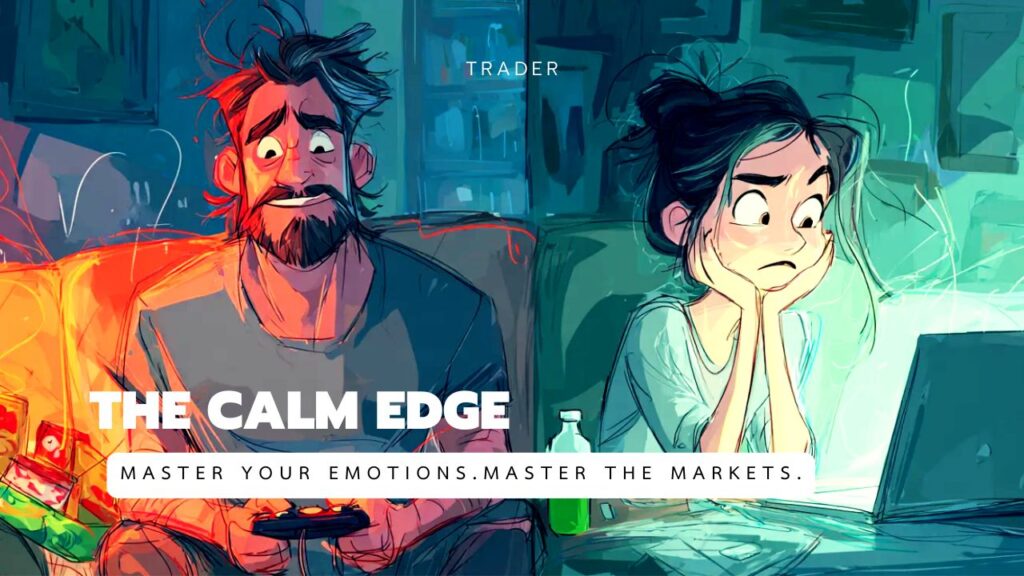Drawdowns are inevitable, panic is optional. In this guide, I’ll share how emotional discipline can help you stay calm when your trading account dips, backed by insights from neuroscience, trading psychology, and my personal recovery journey. You’ll learn how to handle stress, reframe losses, and use journaling, detachment, and self-awareness to trade with clarity no matter what the market throws at you.
Introduction: Drawdowns Don’t Break You. Your Reaction Does
When I faced my first major drawdown, I wasn’t just losing money, I was losing my composure. My screen wasn’t showing numbers; it was showing my self-worth.
That’s the thing about trading. It’s never just about price action. It’s about how you act when the price moves against you.
Every trader, whether in forex, crypto, or stocks eventually faces that brutal stretch when nothing works. The setups you trust stop playing out. Your confidence shakes. You start questioning not just your strategy, but yourself.
But what I learned, painfully is this: drawdowns don’t destroy your trading career. Your emotional reaction to them does.
What Exactly Is a Drawdown And Why It Feels So Personal
Technically, a drawdown is the decline from your account’s peak to its lowest point before a recovery. But in human terms? It’s the space between “I’ve got this” and “What if I lose it all?”
It hits deep because it triggers uncertainty. And our brains hate uncertainty. According to Psychology Today, uncertainty activates the same neural circuits as physical pain.
That’s why when your account dips, it doesn’t just sting, it hurts.
You start over-analyzing every trade. You break your own rules. You chase one big win to erase the pain.
That’s not trading. That’s emotional survival.
And emotional survival is the opposite of emotional discipline.
The Psychology of Loss: When Your Brain Turns Against You
Every time you take a loss, your amygdala, the brain’s fear center fires off like an alarm. It tells you: Danger. You’re losing control.
As Harvard research on decision-making shows, this activates your fight-flight-freeze response. In trading, that looks like this:
-
Fight: You double down to recover losses.
-
Flight: You quit your system and chase a new one.
-
Freeze: You stop pulling the trigger altogether.
This is where emotional reactivity replaces rational strategy. And that’s how temporary drawdowns become permanent setbacks.
The key isn’t to stop feeling fear, it’s to recognize it without reacting to it.
That’s emotional discipline in trading.
What Emotional Discipline in Trading Really Means
Emotional discipline isn’t suppressing emotion. It’s managing it.
It’s choosing to stay aligned with your plan when every instinct screams otherwise.
It’s letting data, not drama, guide your decisions.
It’s knowing your worth doesn’t rise and fall with your equity curve.
A study, found that individuals who practiced emotional regulation under stress performed up to 30% better in high-pressure tasks.
That’s what separates consistent traders from impulsive ones. It’s not their system, it’s their state.
The Hidden Cost of Trading Without Discipline
When you trade emotionally, the visible loss is money. The invisible loss is trust in yourself.
Here’s how it compounds:
-
Overtrading → You burn mental energy and increase risk exposure.
-
Revenge trading → You abandon strategy and rely on impulse.
-
Avoidance → You miss great setups because of fear.
Over time, this chips away at your self-belief, the real capital every trader runs on.
Emotional discipline is how you preserve that capital even when the account dips.
A Real Lesson: The Power of Journaling During Drawdowns
Last year, a swing trader I mentored named Sarah faced a 12% drawdown. She was ready to quit.
Instead, I told her to do one thing: open her trading journal.
She went through her last 15 trades.
She realized she broke her risk rule 6 times.
The market wasn’t her enemy, her emotions were.
After a short pause, she got back to her process. Within eight weeks, she recovered the full drawdown.
She later told me, “The journal didn’t fix my losses. It fixed my perspective.”
If you want to learn how to journal like a pro, read The Role of Journaling in Trading Psychology.
7 Proven Techniques to Stay Calm During Drawdowns
Here’s what I practice and teach, to keep my head steady when the charts go red:
-
The 90-Second Rule
Emotions peak and fade within 90 seconds.
When panic hits, breathe and wait. Don’t touch the mouse. -
Pre-Written Drawdown Plan
Write a rule before it happens:
“If I hit a 2% drawdown, I’ll stop trading for 48 hours and review my journal.” -
Confidence Scoring
Before each trade, rate your conviction 1–10.
Focus on quality, not quantity. -
Limit Screen Time
Watching P&L fluctuate increases cortisol. Set alerts. Step away. -
Mental Rehearsal
Visualize the worst, then picture yourself staying calm through it.
Neuroscience studies show this primes emotional stability. -
Emotional Journaling
Note how you felt before, during, and after each trade.
Awareness precedes control. -
Accountability Partner
Talk weekly with a trusted trader.
Normalizing losses prevents isolation and impulsivity.
Disciplined Trader vs. Emotional Trader
| Trait | Disciplined Trader | Emotional Trader |
|---|---|---|
| Reaction to losses | Reviews journal and resets | Panics and chases |
| Decision process | Rule-based | Impulse-based |
| Focus | Process | Profit |
| Energy | Calm, consistent | Anxious, erratic |
| Belief | “I’m managing risk.” | “I must win back losses.” |
| Outcome | Long-term growth | Repeated burnout |
This simple contrast shows that consistency is born from composure, not control.
Mindset Shift: Detachment Over Drama
Morgan Housel once said, “Every financial decision has a psychological foundation underneath it.”
He’s right.
When you detach from your emotions, you start seeing the market as it is, not as you feel it is.
A detached trader doesn’t chase revenge trades. They don’t panic during volatility. They trust their edge, even when it’s tested.
That’s what I call trading from presence, not pressure.
Daily Habits That Build Emotional Discipline
| Habit | Why It Works |
|---|---|
| 10-min Morning Meditation | Builds awareness before chaos begins |
| Daily Trade Review | Reinforces pattern recognition |
| Weekly Deep Journaling | Creates long-term perspective |
| Phone-Free Walks | Clears mental noise |
| Affirmation Routine | Rewires subconscious beliefs like “I stay calm under pressure” |
These small habits don’t just make you a better trader, they make you a more centered human being.
Real Examples: How Traders Recovered From Drawdowns
Forex Trader: News Volatility
-
Problem: Overtrading during announcements
-
Fix: Journaling revealed 80% of losses occurred 15 minutes post-news
-
Result: Instituted a 30-minute no-trade window and cut drawdowns by 18%
Crypto Trader: FOMO Cycle
-
Problem: Entered impulsive trades after a red streak
-
Fix: Added a “confidence tracker” before trades
-
Result: Reduced overtrading by 50% within 2 months
Stock Day Trader: Morning Panic Trades
-
Problem: Entered first candle impulsively
-
Fix: Added a 15-minute pre-market mindfulness routine
-
Result: Improved win rate from 48% to 61%
Conclusion: Calm Is a Superpower
I’ve learned this both in trading and in life, especially after my injury:
You can’t always control what happens, but you can always control how you respond.
Drawdowns test that truth.
The traders who thrive aren’t the ones who never fall, they’re the ones who know how to stand up without panic.
So the next time you’re deep in a drawdown, remember:
You’re not losing. You’re learning to stay calm under pressure.
Repeat this:
“My emotions don’t control my trades. My process does.”
That’s emotional discipline. That’s resilience.
When I faced my first drawdown, I thought it was about the money. It never was. It was about mastering myself.
If this story spoke to you, join The Reborn Trader newsletter. I share weekly lessons on trading psychology, mindset, and emotional resilience.
And if you’re ready to go deeper, my coaching helps traders rebuild clarity and confidence from the inside out.
FAQs
What is emotional discipline in trading?
Emotional discipline in trading refers to the ability to regulate your reactions to wins and losses. It helps traders stay consistent and avoid impulsive decisions during drawdowns.
How do you stay calm during a trading drawdown?
Use techniques like journaling, the 90-second rule, pre-written drawdown plans, and emotional tracking. These tools help build awareness and reduce panic.
Why do most traders lose money during drawdowns?
Most traders let emotions like fear and revenge take over. Without emotional discipline, they overtrade, abandon plans, or chase losses leading to bigger setbacks.
What’s the first step to becoming emotionally disciplined?
Awareness. Track your emotional triggers before they control you.
How can I train my emotions to handle losses better?
Use mindfulness, journaling, and pre-set trading rules to regulate your nervous system.




